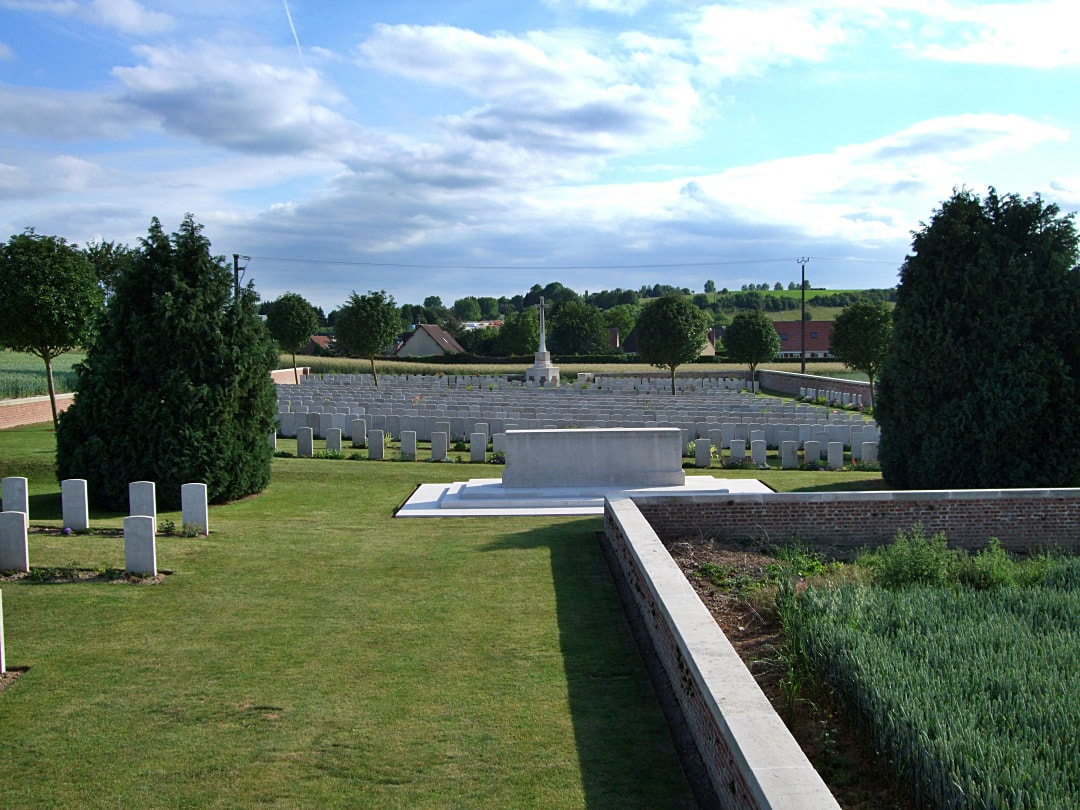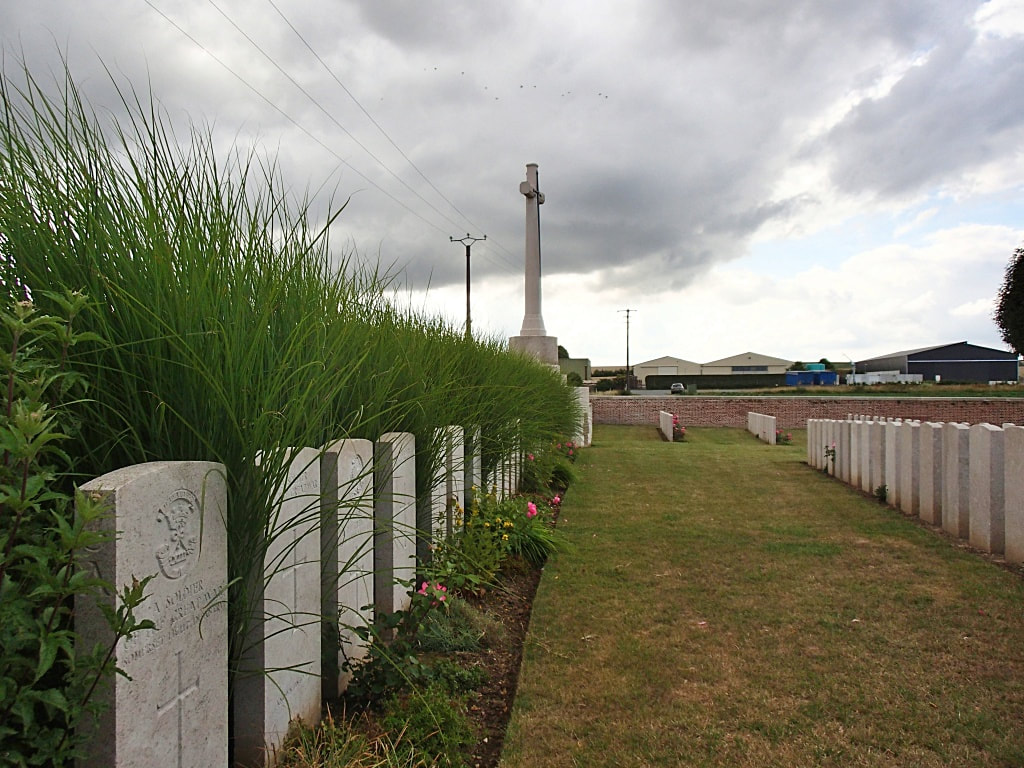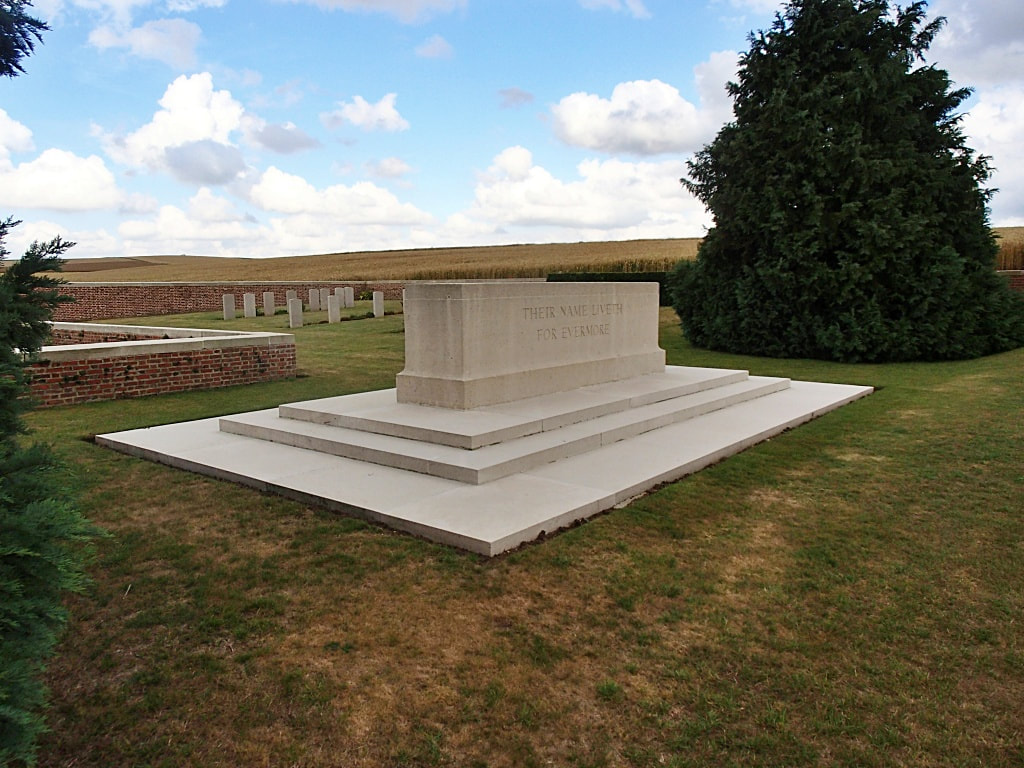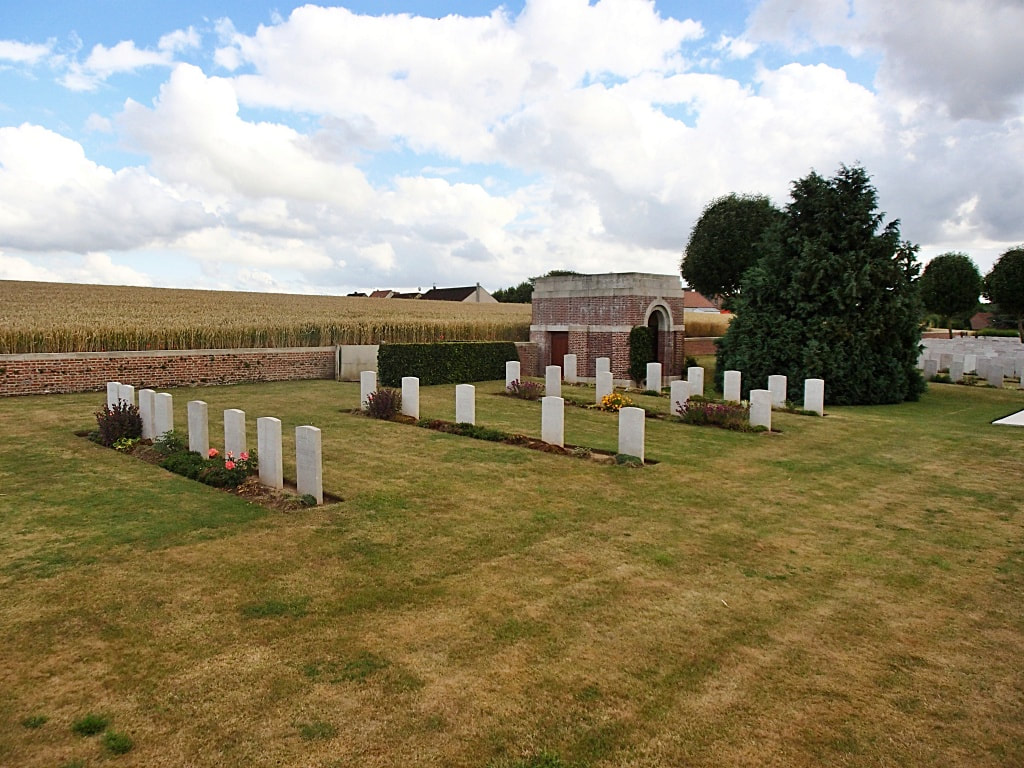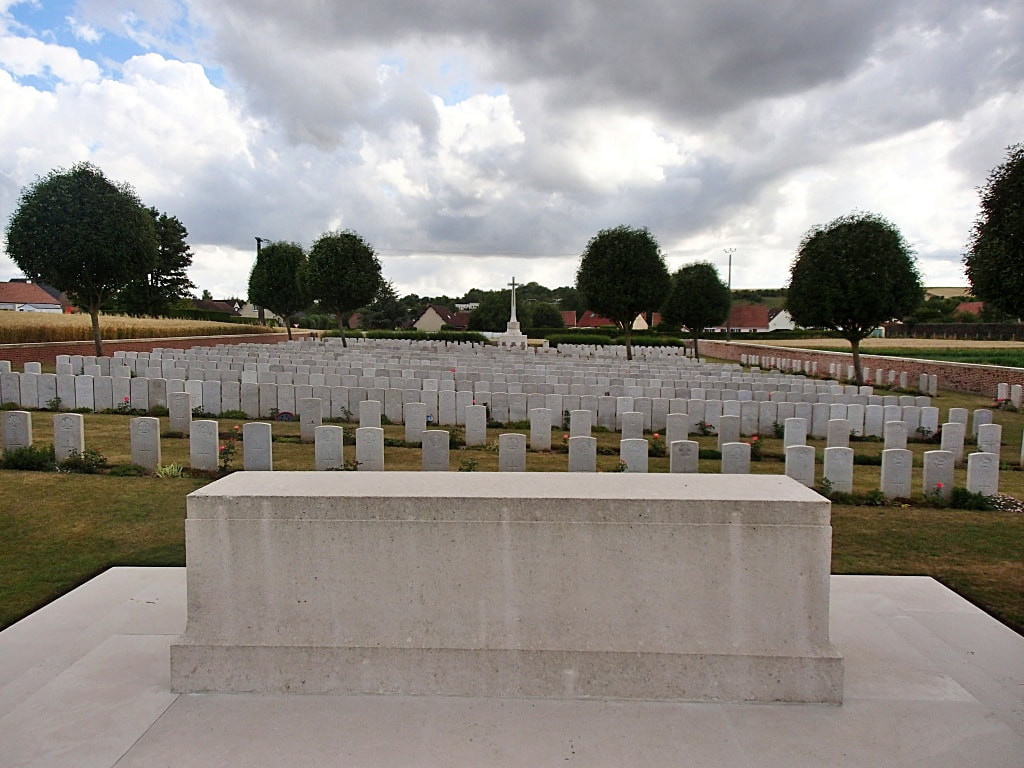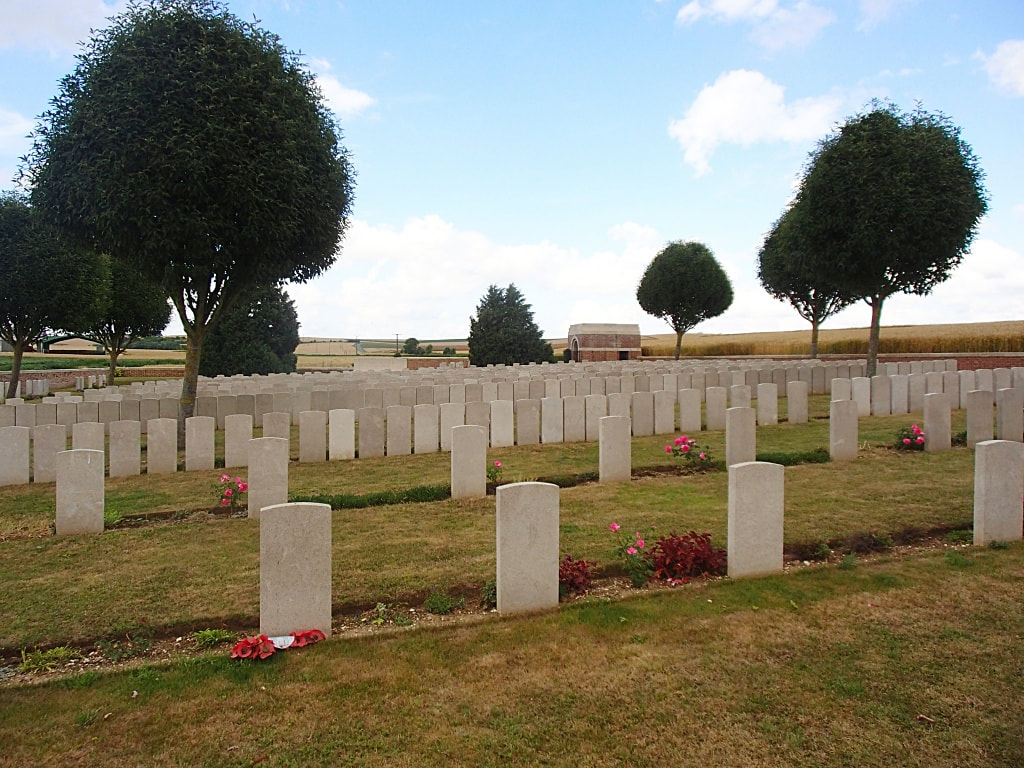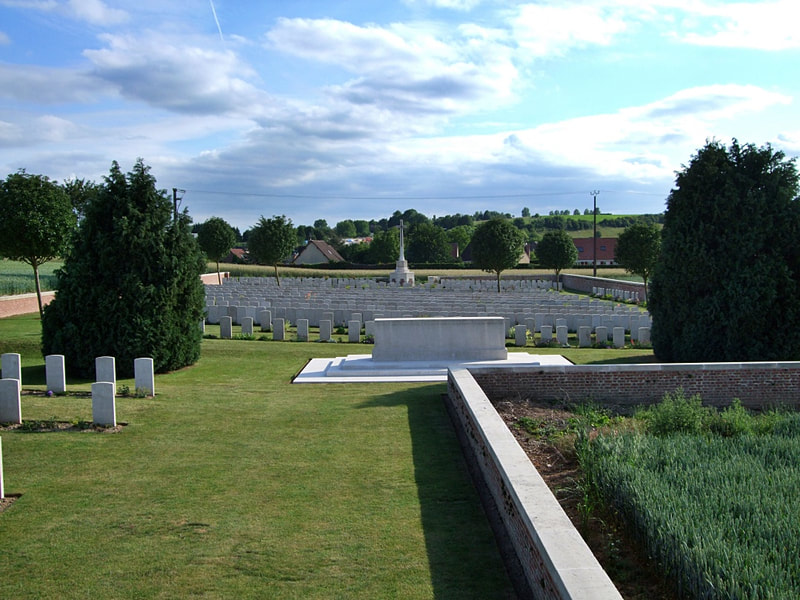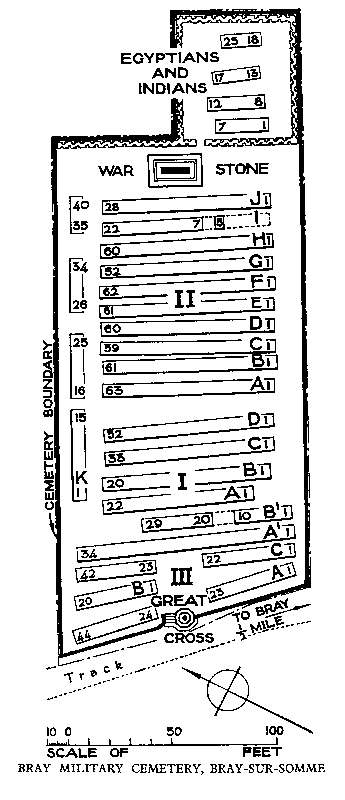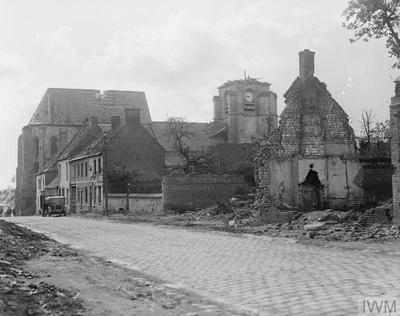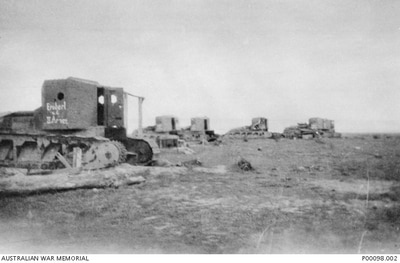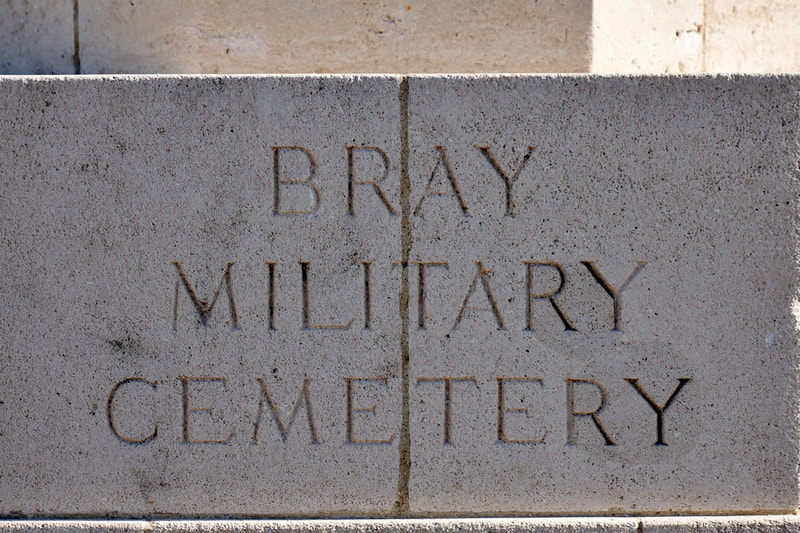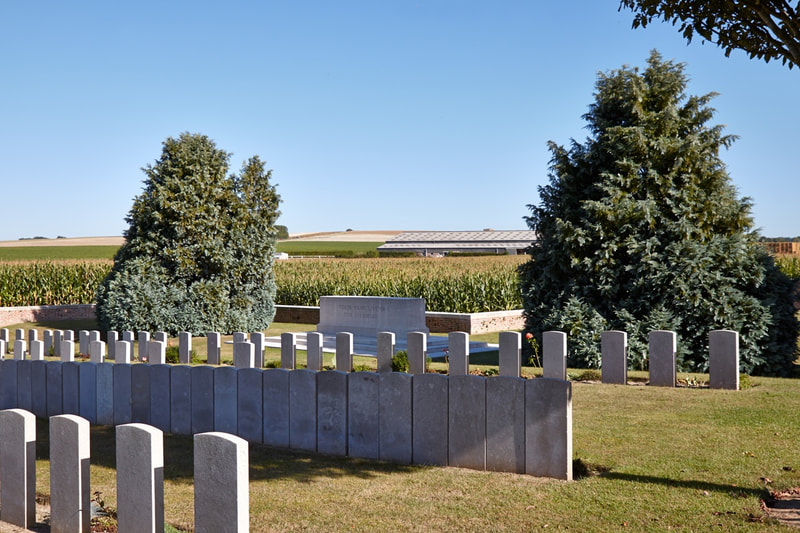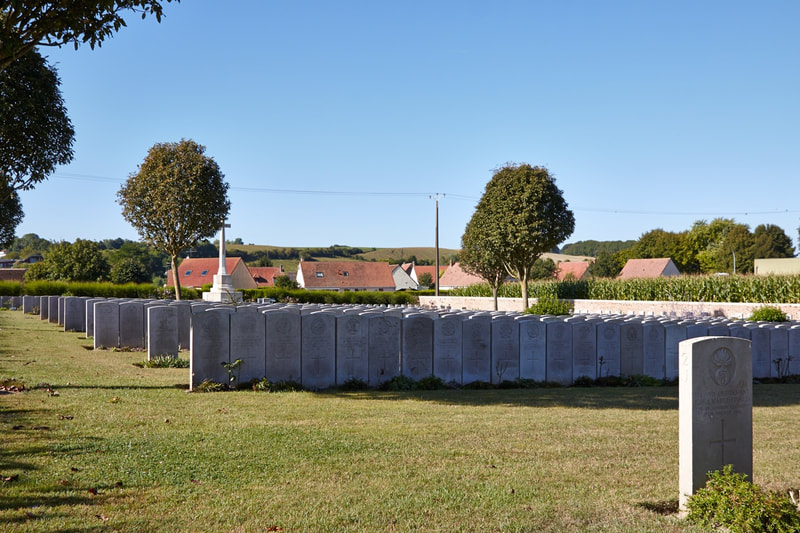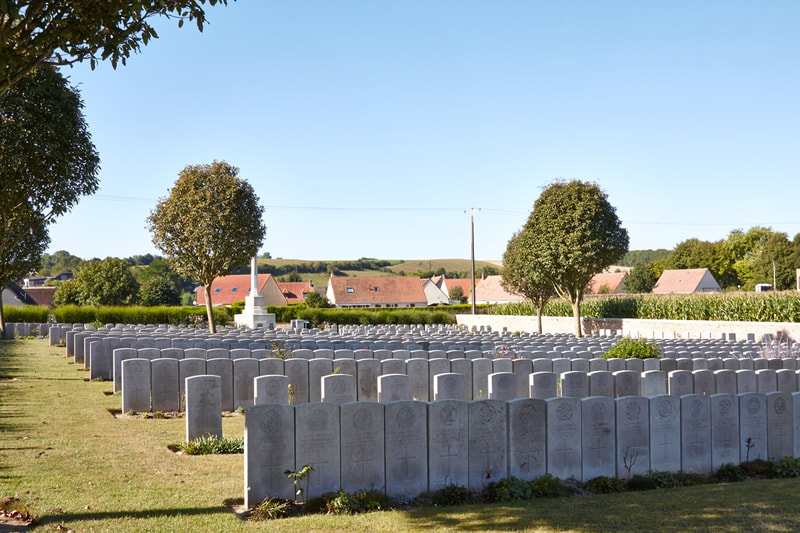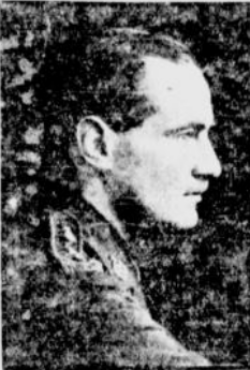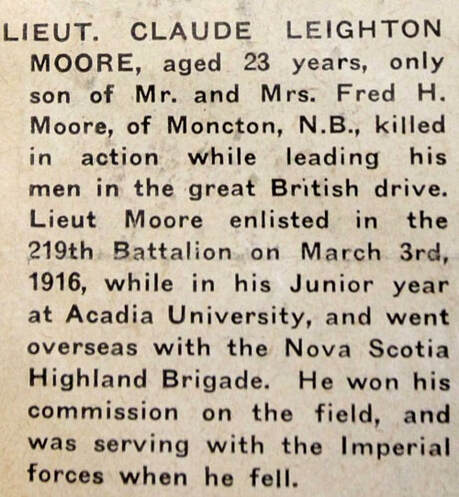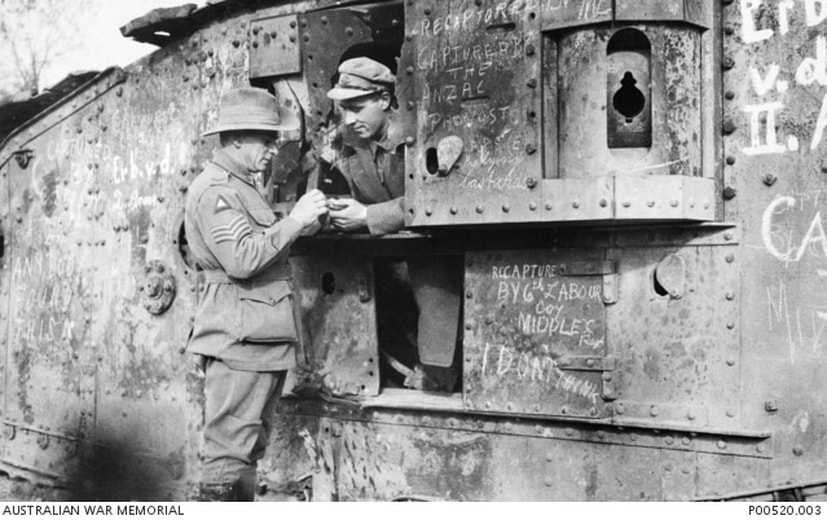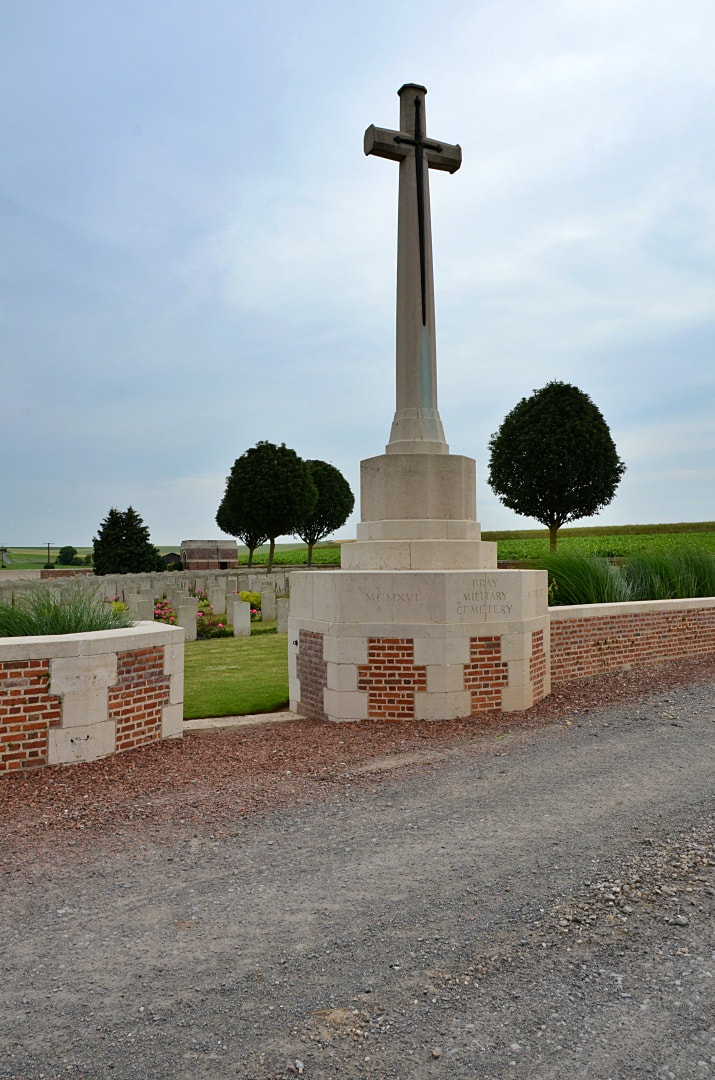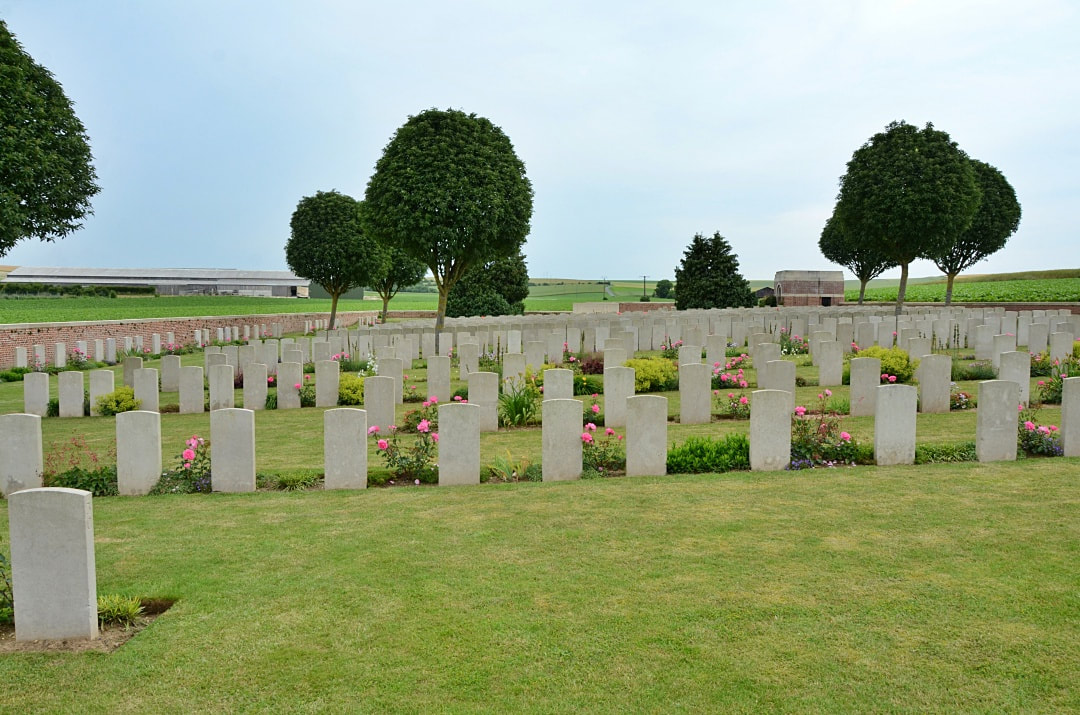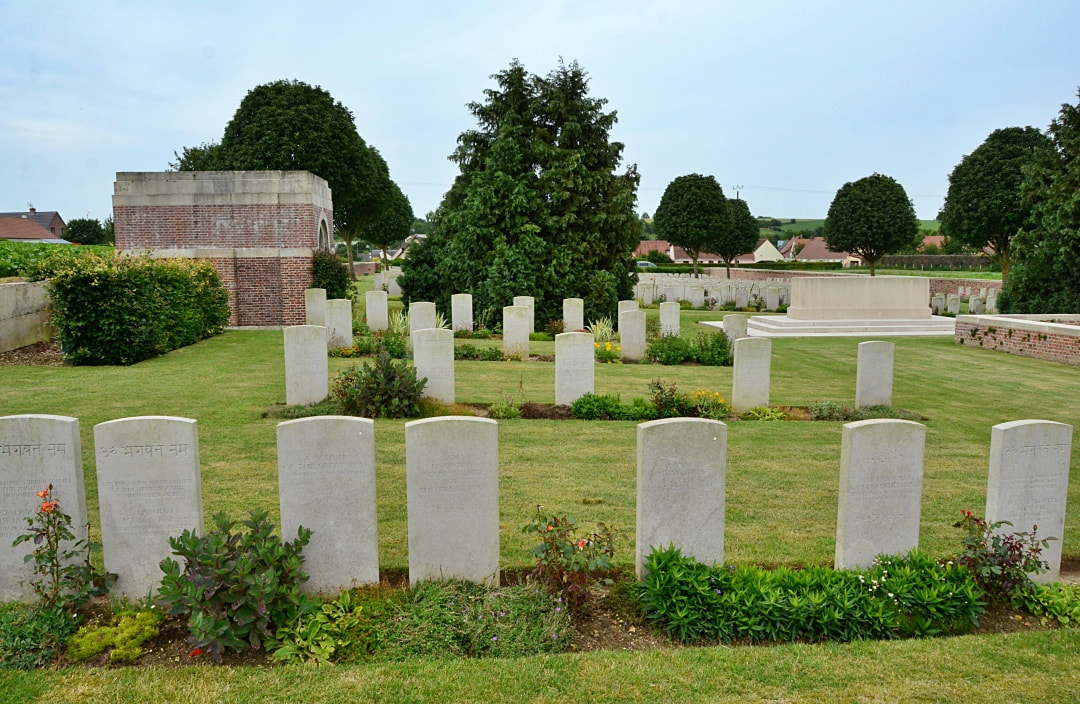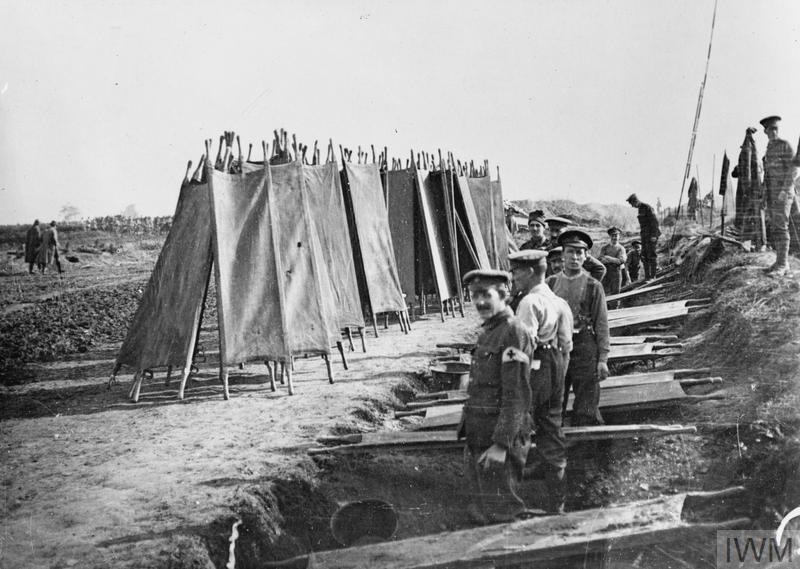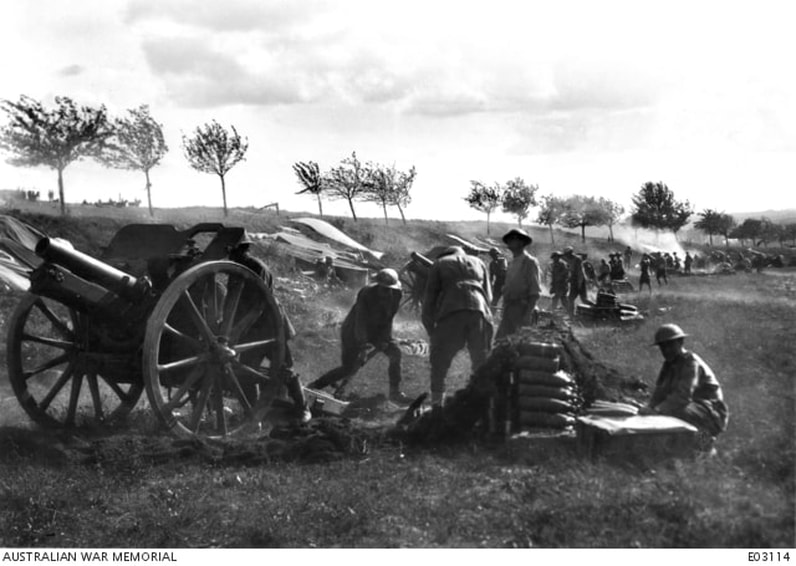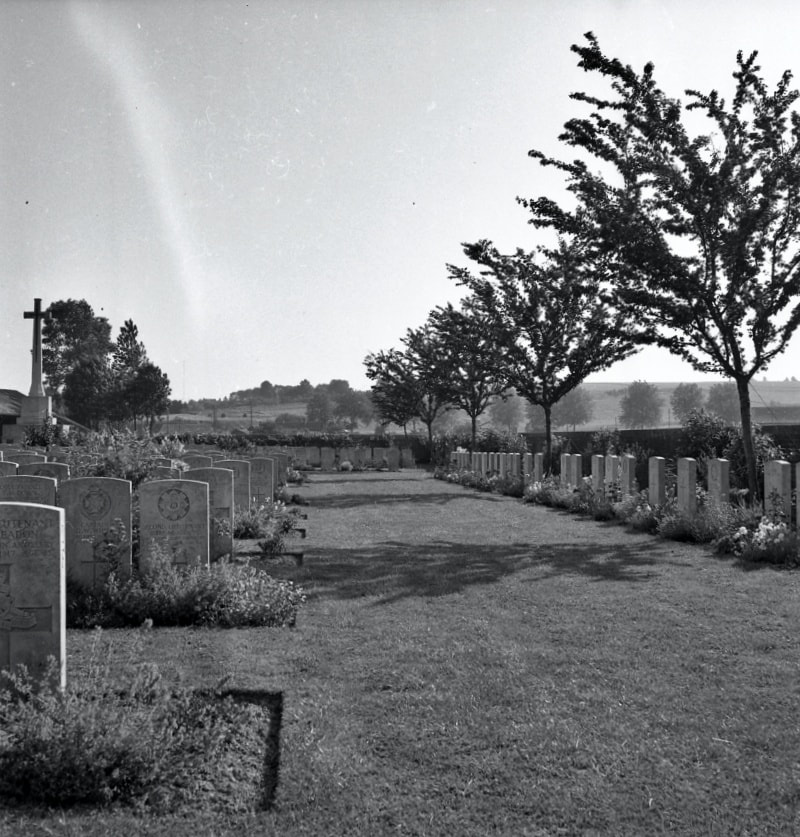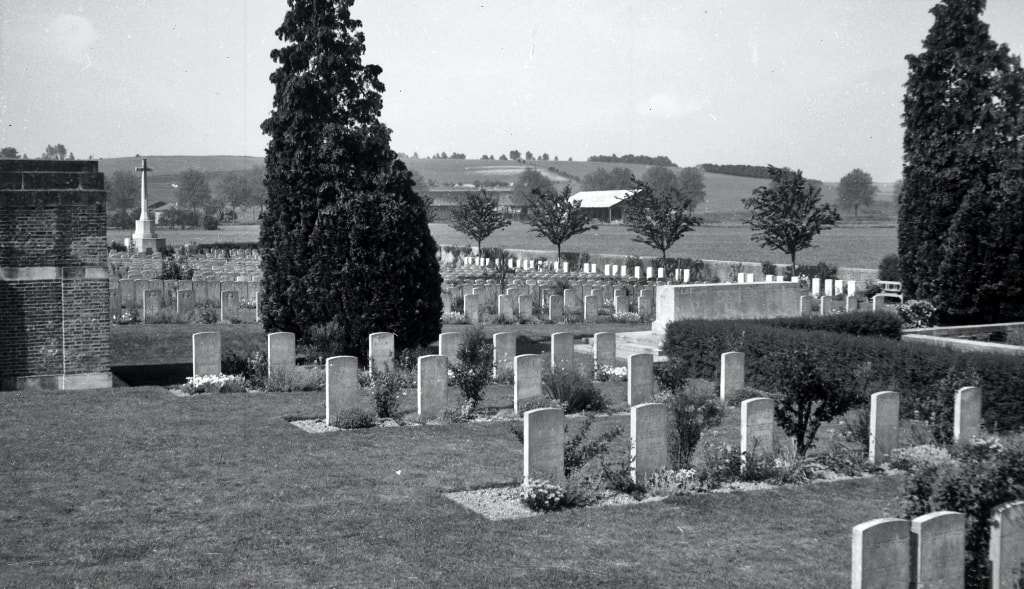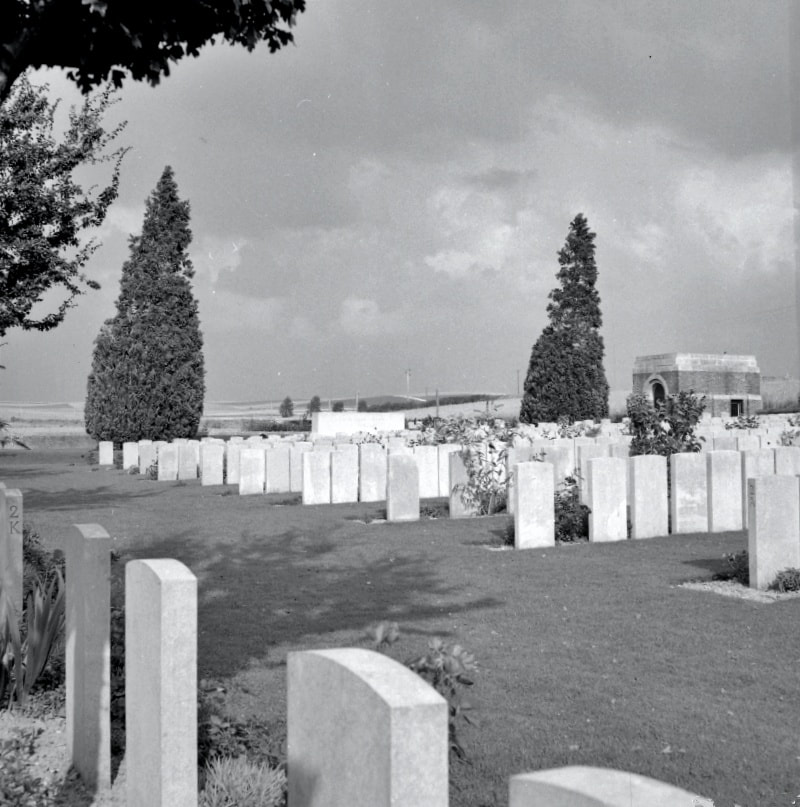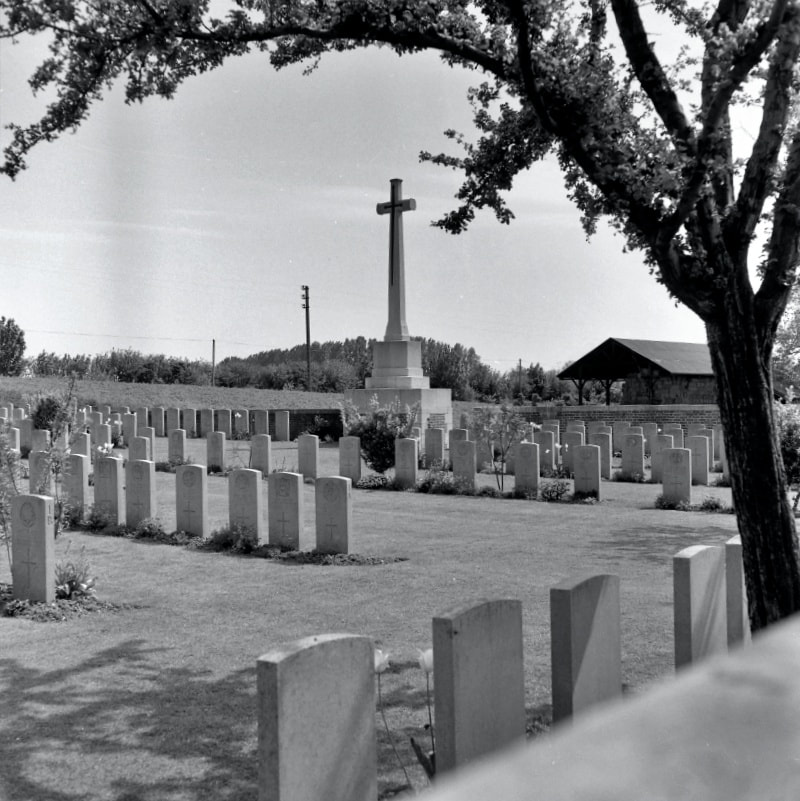BRAY MILITARY CEMETERY
Somme
France
GPS Coordinates Latitude: 49.9472 Longitude: 2.71949
Location Information
Bray-sur-Somme is a village about 9 kilometres south-east of Albert. Bray Military Cemetery is north of the village, a little west of the road to Maricourt.
Historical Information
The cemetery was begun in April 1916 by fighting units and field ambulances. In September 1916, the front line having been pushed further east, it was used by the XIV Corps Main Dressing Station and in 1917, the 5th, 38th and 48th Casualty Clearing Stations came forward and used it. In March 1918, the village and the cemetery fell into German hands, but were retaken by the 40th Australian Battalion on 24 August, and during the next few days the cemetery was used again.
After the Armistice graves were brought in to Plot I, Rows A1 and B1, and Plot II, Rows J and K, from the battlefields immediately north and south of the village and in 1924, further isolated graves (Plot III) were brought in.
Bray Military Cemetery now contains 875 Commonwealth burials of the First World War, 127 of which are unidentified.
Total Burials: 875.
Identified Casualties: United Kingdom 702, Australia 29, India 12, Canada 3, South Africa 1. Total 747.
Unidentified Casualties: 127.
The cemetery was designed by Sir Reginald Blomfield and Arthur James Scott Hutton
Dedications
R/38156 Rifleman Timothy Hennessey, 10th Bn. King's Royal Rifle Corps. 10th April 1917, aged 35. Son of James and Julia Hennessey, of London.
Remembered with pride by his family, submitted by Patricia Darcy
Bray-sur-Somme is a village about 9 kilometres south-east of Albert. Bray Military Cemetery is north of the village, a little west of the road to Maricourt.
Historical Information
The cemetery was begun in April 1916 by fighting units and field ambulances. In September 1916, the front line having been pushed further east, it was used by the XIV Corps Main Dressing Station and in 1917, the 5th, 38th and 48th Casualty Clearing Stations came forward and used it. In March 1918, the village and the cemetery fell into German hands, but were retaken by the 40th Australian Battalion on 24 August, and during the next few days the cemetery was used again.
After the Armistice graves were brought in to Plot I, Rows A1 and B1, and Plot II, Rows J and K, from the battlefields immediately north and south of the village and in 1924, further isolated graves (Plot III) were brought in.
Bray Military Cemetery now contains 875 Commonwealth burials of the First World War, 127 of which are unidentified.
Total Burials: 875.
Identified Casualties: United Kingdom 702, Australia 29, India 12, Canada 3, South Africa 1. Total 747.
Unidentified Casualties: 127.
The cemetery was designed by Sir Reginald Blomfield and Arthur James Scott Hutton
Dedications
R/38156 Rifleman Timothy Hennessey, 10th Bn. King's Royal Rifle Corps. 10th April 1917, aged 35. Son of James and Julia Hennessey, of London.
Remembered with pride by his family, submitted by Patricia Darcy
Images in gallery below © Geerhard Joos
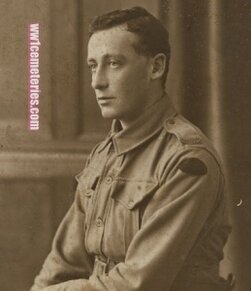
3010 Private
Fred Cadwallader Allen
37th Bn. Australian Infantry, A. I. F.
25th August 1918, aged 24.
Plot I. BI. 4.
Son of Robert and Sarah Ann Allen, of 6, Melbourne Rd., Geelong, Victoria. Native of Talbot, Victoria, Australia.
His headstone bears the inscription "Dear Fred Loved Son Of Robert Allen Of Talbot, Victoria Our Hero"
Killed while marching through Bray on the way to the front line when a High Explosive shell exploded amongst the column.
Fred Cadwallader Allen
37th Bn. Australian Infantry, A. I. F.
25th August 1918, aged 24.
Plot I. BI. 4.
Son of Robert and Sarah Ann Allen, of 6, Melbourne Rd., Geelong, Victoria. Native of Talbot, Victoria, Australia.
His headstone bears the inscription "Dear Fred Loved Son Of Robert Allen Of Talbot, Victoria Our Hero"
Killed while marching through Bray on the way to the front line when a High Explosive shell exploded amongst the column.
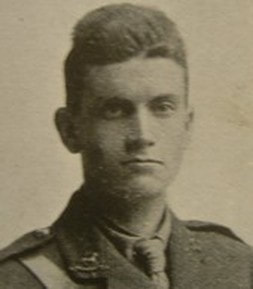
Second Lieutenant
Hubert Stephen Slepowron De Jastrzebski
24th Bn. London Regiment
5th April 1917, aged 22.
Plot II. H. 59.
Son of Thaddeus Theodore and Frances Elizabeth Slepowron de Jastrzebski, of "Kirklees," 102, Avondale Rd., South Croydon, Surrey.
His headstone bears the inscription"Sanguis Heroum Semen Liberatis"
Hubert Stephen Slepowron De Jastrzebski
24th Bn. London Regiment
5th April 1917, aged 22.
Plot II. H. 59.
Son of Thaddeus Theodore and Frances Elizabeth Slepowron de Jastrzebski, of "Kirklees," 102, Avondale Rd., South Croydon, Surrey.
His headstone bears the inscription"Sanguis Heroum Semen Liberatis"
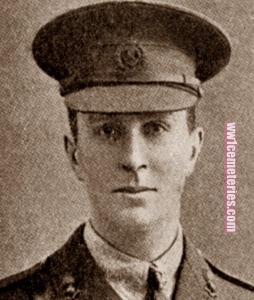
Captain
John Archibald Field
92nd Field Coy. Royal Engineers
13th July 1916, aged 32.
Plot I. B. 7.
Son of Mrs. Field, of "Chellowdean," Woodside Green, South Norwood, London.
His headstone bears the inscription "Not Lost But Gone Before"
John Archibald Field
92nd Field Coy. Royal Engineers
13th July 1916, aged 32.
Plot I. B. 7.
Son of Mrs. Field, of "Chellowdean," Woodside Green, South Norwood, London.
His headstone bears the inscription "Not Lost But Gone Before"

20927 Private
Charles Ford
1st Bn. Cameronians (Scottish Rifles)
18th February 1917, aged 21.
Plot II. C. 52.
Son of Job and Kate Emily Ford, of 18, Clarence Terrace, West End, Willington, Co. Durham. Native of Oakenshaw, Willington.
Picture courtesy of Christopher Ecclestone, cousin, once removed
Charles Ford
1st Bn. Cameronians (Scottish Rifles)
18th February 1917, aged 21.
Plot II. C. 52.
Son of Job and Kate Emily Ford, of 18, Clarence Terrace, West End, Willington, Co. Durham. Native of Oakenshaw, Willington.
Picture courtesy of Christopher Ecclestone, cousin, once removed
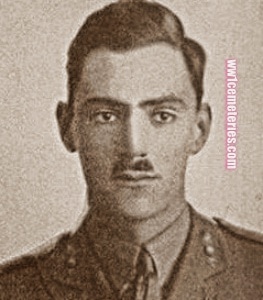
Captain
Frank Woolfe Haldinstein
8th Signal Coy. Royal Engineers
7th March 1917, aged 22.
Plot II. D. 40.
Son of Alfred and Edith Haldinstein, of Thorpe Lodge, Norwich.
His headstone bears the inscription "We Dreamt Great Things For You God Intervened And So The Dream Came True"
Frank Woolfe Haldinstein
8th Signal Coy. Royal Engineers
7th March 1917, aged 22.
Plot II. D. 40.
Son of Alfred and Edith Haldinstein, of Thorpe Lodge, Norwich.
His headstone bears the inscription "We Dreamt Great Things For You God Intervened And So The Dream Came True"
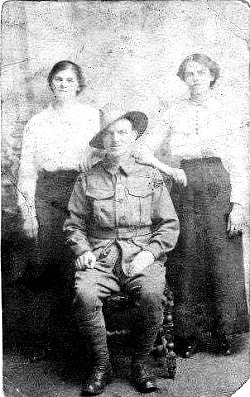
919 Private
Arthur Tanney
35th Bn. Australian Infantry
22nd August 1918, aged 31.
Plot II. 1. 12.
Son of Patrick and Elizabeth Tanney, of 95, New Row, New Delaval, Newsham, Northumberland, England. Native of Cowpen, Northumberland.
His headstone bears the inscription "Come To Me All You That Labour And Are Burdened And I Will Refresh You. R. I. P."
The photo was taken in the North East of England where he originated from and where he visited after embarking In Plymouth or Southampton with his Australian fellow soldiers. The two women in the picture are his mother Elizabeth and his sister whose name I do not have. He was killed by a shell on the 31Aug 2018 having twice being wounded before his death. Arthur Tanney was 29 years when he died. His name is also on a war memorial in Kerri Kerri NSW Australia.
Picture and information © Kevin Wilde
Arthur Tanney
35th Bn. Australian Infantry
22nd August 1918, aged 31.
Plot II. 1. 12.
Son of Patrick and Elizabeth Tanney, of 95, New Row, New Delaval, Newsham, Northumberland, England. Native of Cowpen, Northumberland.
His headstone bears the inscription "Come To Me All You That Labour And Are Burdened And I Will Refresh You. R. I. P."
The photo was taken in the North East of England where he originated from and where he visited after embarking In Plymouth or Southampton with his Australian fellow soldiers. The two women in the picture are his mother Elizabeth and his sister whose name I do not have. He was killed by a shell on the 31Aug 2018 having twice being wounded before his death. Arthur Tanney was 29 years when he died. His name is also on a war memorial in Kerri Kerri NSW Australia.
Picture and information © Kevin Wilde
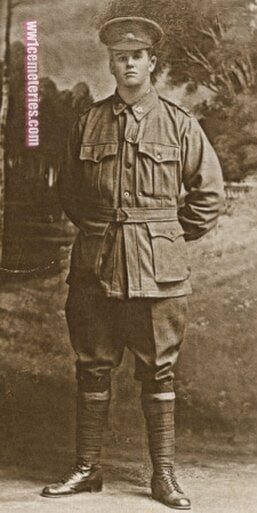
3408 Private
Norman Leslie Wheaton
33rd Bn. Australian Infantry, A. I. F.
22nd August 1918, aged 22.
Plot II. I. 7.
Son of John and Elizabeth Wheaton, of Eumungerie, New South Wales. Native of South Australia.
A farmer and grazier prior to enlistment, Pte Wheaton embarked with the 8th Reinforcements, 33rd Battalion from Sydney on HMAT Port Melbourne (A16) on 16 July 1917. He was killed in action in France on 22 August 1918, aged 22.
Killed close to Bray-sur-Somme on the morning of 22nd August 1918, Private Wheaton had "Hopped over" into the attack at 4.20am and had gone only a few yards when he was hit in the chest by a machine gun bullet, killing him instantly.
Norman Leslie Wheaton
33rd Bn. Australian Infantry, A. I. F.
22nd August 1918, aged 22.
Plot II. I. 7.
Son of John and Elizabeth Wheaton, of Eumungerie, New South Wales. Native of South Australia.
A farmer and grazier prior to enlistment, Pte Wheaton embarked with the 8th Reinforcements, 33rd Battalion from Sydney on HMAT Port Melbourne (A16) on 16 July 1917. He was killed in action in France on 22 August 1918, aged 22.
Killed close to Bray-sur-Somme on the morning of 22nd August 1918, Private Wheaton had "Hopped over" into the attack at 4.20am and had gone only a few yards when he was hit in the chest by a machine gun bullet, killing him instantly.
Shot at Dawn
23972 Corporal Jesse Wilton. 15th Bn. Sherwood Foresters (Notts and Derby Regiment), executed for quitting his post on 17th August 1916, aged 40.Plot II. K. 11. Husband of Annie Elizabeth Wilton, of 17, Brooking Dunsaille, Doncaster, Yorks.
He joined up in Feb 1915, arriving in France a year later. By 19 July, his battalion was serving on the Somme, & Wilton was ordered to take 10 men to garrison an isolated forward post in No-man’s-land, to be held at all costs, for 48 hours. 43 hours later, the corporal arrived back with his men in the front line trench. There had been heavy machine-gun fire & shelling (but it seems no casualties); & Wilton had discussed with one of his privates what to do, & had then himself decided to bring his men out, saying at the time that he thought the Germans were coming.
At trial, Wilton was unrepresented, & did not dispute any of the evidence, stating that his nerves & those of his men had been very much shaken. His CO reported that, though Wilton had performed well in action on several occasions, he was a failure as a NCO, since he came from the same class of men as those in the ranks; & further opined that it would have been comparatively easy for the corporal to have sent a message to his company commander seeking fresh orders. (Corns, pp.152-153)
23972 Corporal Jesse Wilton. 15th Bn. Sherwood Foresters (Notts and Derby Regiment), executed for quitting his post on 17th August 1916, aged 40.Plot II. K. 11. Husband of Annie Elizabeth Wilton, of 17, Brooking Dunsaille, Doncaster, Yorks.
He joined up in Feb 1915, arriving in France a year later. By 19 July, his battalion was serving on the Somme, & Wilton was ordered to take 10 men to garrison an isolated forward post in No-man’s-land, to be held at all costs, for 48 hours. 43 hours later, the corporal arrived back with his men in the front line trench. There had been heavy machine-gun fire & shelling (but it seems no casualties); & Wilton had discussed with one of his privates what to do, & had then himself decided to bring his men out, saying at the time that he thought the Germans were coming.
At trial, Wilton was unrepresented, & did not dispute any of the evidence, stating that his nerves & those of his men had been very much shaken. His CO reported that, though Wilton had performed well in action on several occasions, he was a failure as a NCO, since he came from the same class of men as those in the ranks; & further opined that it would have been comparatively easy for the corporal to have sent a message to his company commander seeking fresh orders. (Corns, pp.152-153)
Images in this gallery © Johan Pauwels
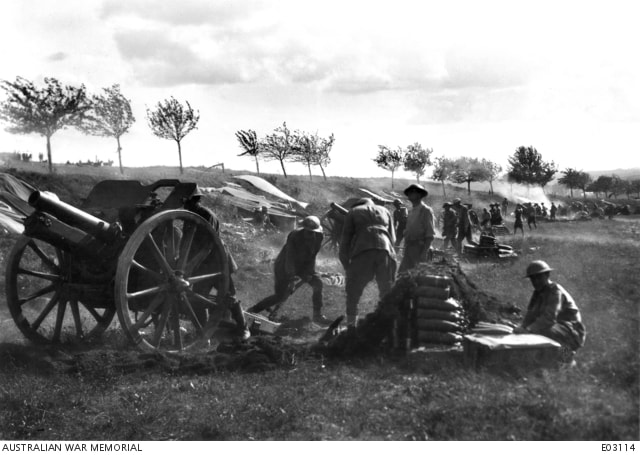
The 108th Howitzer Battery in action at Bray using 4.5 inch Mk I Howitzers. The troops of the 3rd Australian Division whom the Battery was supporting were then engaged beyond Suzanne. Identified, left to right: 21492 Corporal J. F. Yates MM (partially obscured by the gun); 21437 Bombardier John Thomas Wharton MM (shovelling); 37417 Gunner (Gnr) Charles Edward Harnett (back to camera); 24557 Gnr C. F. H. Ipsen (looking up); 23094 Gnr John Southwell (extreme right foreground); 32887 Gnr Charles Edward Dun (in the background between Harnett and Ipsen); 23073 Gnr A. McDonald (directly behind Ipsen); 32962 Gnr Stockley (behind McDonald).

26th August 1918; The village of Bray, photographed from the north east. Bray was taken on the night of 23 August 1918, by a direct frontal surprise attack, of the 40th (Australian) Battalion, assisted on the left flank by the 37th and 38th Battalions. The railway station is in the foreground and directly behind is the ruined church used as a hospital by the enemy. The structure on the right is a field telephone distribution small tower.

